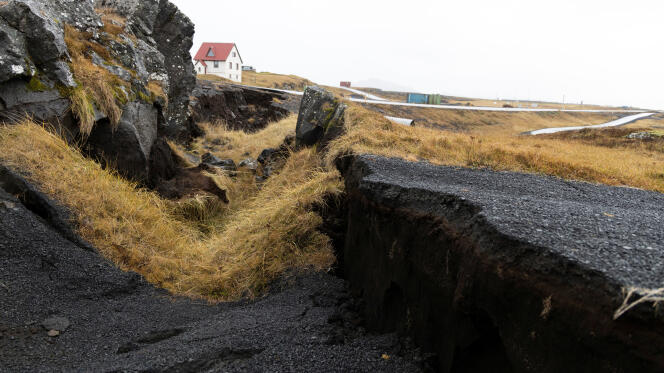It could take place in a few hours, a few days or a few weeks. Or maybe not at all. On Wednesday, November 15, the Icelandic Meteorological Office (Met) estimated, however, that the probability of an eruption on the Reykjanes peninsula, in the southwest of the country, remained. “high”.
In the meantime, Iceland is holding its breath and preparing. Because the island, located on the Atlantic ridge, between the North American and Eurasian tectonic plates, has thirty-three active volcanic systems, the highest number in Europe, and one of its cities is this time threatened.
On Friday, a state of emergency was declared and the port of Grindavik, about sixty kilometers from the capital, Reykjavik, was evacuated. Since then, its 3,700 inhabitants – or 1% of the Icelandic population – have been able to return home and collect personal belongings. But on condition that you only stay a few minutes and are accompanied by rescuers.
“No more than one hour’s notice”
Because the damage is significant, as shown by the images of broken roads and cracked buildings. Not to mention that the situation, “unchanged for four days”according to the Met, could quickly evolve: “Before an eruption, we should see minor changes in ground deformation and seismic activity, but don’t expect more than half an hour or an hour’s notice.”estimates geophysicist Freysteinn Sigmundsson.
On the Reykjanes Peninsula, lava had not flowed for eight centuries, when it suddenly gushed from a fissure on March 19, 2021, near Mount Fagradalsfjall, attracting thousands of tourists. Since then, two other eruptions have occurred in the vicinity, in August 2022 and July 2023, each time in areas far from any habitation. According to the Met, fractures caused in the Earth’s crust on these occasions could explain the rapidity with which magma rose to the surface in recent days.
For several weeks already, the earth had been shaking around Grindavik. “We knew that an accumulation of magma had formed, about 5 kilometers deep, which was causing the tremors”, explains Magnus Tumi Gudmundsson, professor of geophysics at the University of Iceland. He pursues : “On Friday evening, a crack formed in the earth’s crust and the magma rose vertically at very high speed. If it had made it to the surface we would have had a massive eruption, but it stopped about 800 meters deep. »
You have 50% of this article left to read. The rest is reserved for subscribers.
